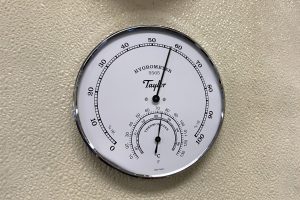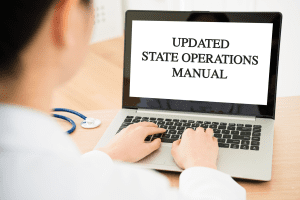September 2025
Inside This Issue
New Standards:
This month’s edition of Perspectives provides additional insight on their new standards format. The free webinars they discussed last month are now starting to be available and we would encourage readers to take the time to view these and become comfortable with the new standards and Survey Process Guide (SPG).
Perspectives also discusses how the new free-to-the-public version of the standards have become available which are posted to The Joint Commission’s public website. These are free for viewing, but not for downloading or printing; those features remain available only in the E-dition. They do mention that organizations considering Joint Commission accreditation can obtain 90 days of access to the E-dition to learn more about the standards.
 One of the things we have noted is the Day 1 Document List is substantially smaller than the existing version; the new list contains only 17 documents which must be available at the start of a survey. There are additional documents which need to be made available at the end of Day 1 or during specific survey tracer sessions, so take a look in the new SPG to help organize next year’s documents.
One of the things we have noted is the Day 1 Document List is substantially smaller than the existing version; the new list contains only 17 documents which must be available at the start of a survey. There are additional documents which need to be made available at the end of Day 1 or during specific survey tracer sessions, so take a look in the new SPG to help organize next year’s documents.
Patton Preparation:
As consultants, we also need to “get ready” for the new TJC standards. Here at PHC, we have been working hard by redesigning our current database while simultaneously developing a revolutionary AI-enabled software, Comply-IQ. As we gear up for the TJC standards go-live, remote education sessions have taken place to help orient our bench of experts to the new format, standards, and reference numbers. We have also already started to conduct consultant surveys using the updated standards for our clients preparing for their 2026 accreditation survey.
Staff Competency Initial Assessment Standard:
 The familiar Consistent Interpretation column returned this month, discussing existing standard HR.01.06.01, EP 5, which next year becomes HR.11.04.01, EP 1. The consistent interpretation column contains several paragraphs of details which provide context on the applicability of this standard that may be useful to read as this context does not appear to be in either the existing or 2026 version of the standards. We did check the new Survey Process Guide and there are seven (7) references scattered throughout that provide similar context and details. We would suggest reading both to assess if you are satisfied that your competency assessment process is adequate.
The familiar Consistent Interpretation column returned this month, discussing existing standard HR.01.06.01, EP 5, which next year becomes HR.11.04.01, EP 1. The consistent interpretation column contains several paragraphs of details which provide context on the applicability of this standard that may be useful to read as this context does not appear to be in either the existing or 2026 version of the standards. We did check the new Survey Process Guide and there are seven (7) references scattered throughout that provide similar context and details. We would suggest reading both to assess if you are satisfied that your competency assessment process is adequate.
Missing from this month’s column is data about last year’s scoring frequency, but it is our observation that scoring is somewhat frequent, often due to overlooking regulatory or clinical practice guideline requirements on issues such as sterile instrument processing or sterile compounding.
 2026 Survey Process Guide for Physical Environment:
2026 Survey Process Guide for Physical Environment:
The September issue of EC News has a very helpful article describing the guides and tools available for 2026 to help prepare for survey of the physical environment (PE). The 626-page Survey Process Guide (SPG) contains a hospital PE evaluation module starting on page 222 detailing The Joint Commission standards and CMS regulations. For compliance with the NFPA Life Safety Code, starting on page 433 there is a NFPA 101 and NFPA 99 Ambulatory Healthcare Occupancy Evaluation Tool using CMS’ familiar K-Tag format. The NFPA 101 and 99 Healthcare Occupancy tool is found beginning on page 490. We also noted that the table of contents for the SPG contains hyperlinks so if you click on the desired item in the contents, it takes you right to the desired page in the guide.
The EC News lead story discusses additional tools including the Fire Drill Matrix, the Kitchen Tracer Tool, the Imaging Inspection, Maintenance and Testing Guide, and a Workplace Violence Evaluation Tool. These tools are particularly helpful in preparing for the physical environment portion of the survey, which has become one of the most difficult parts of any hospital survey. Also, remember TJC is expanding use of the life safety code specialists to include looking at business occupancies which may add to the total duration of life safety code specialists on site.
 Aging Infrastructure:
Aging Infrastructure:
EC News has an article they titled “Breaking Point” which discusses the aging infrastructure of many hospitals. There is a frightening statistic from the American Society of Health Care Engineering (ASHE) that says many health systems have some really old buildings with 79% of systems reporting a building older than 50 years. They point out some of the problematic consequences of these aged buildings when pipes, chillers, boilers or other components break. Such aging infrastructure can sometimes lead to floods or other damage to newer sections of the organization. The article provides a tips section of ten (10) potential red flags that could be indicators of trouble on the horizon from aged equipment or buildings.
Temperature, Humidity and Air Pressure Relationships:
 The September issue of EC News has an article on maintaining proper temperature, humidity and air pressure relationships in critical spaces. TJC even created a new acronym for this requirement that we had not heard previously called THUMPR. While this was not explained in the article SIG advised it was T for temperature, HUM for humidity and PR for pressure. So, a rather unique 1-letter, 3-letter, 2-letter acronym was developed.
The September issue of EC News has an article on maintaining proper temperature, humidity and air pressure relationships in critical spaces. TJC even created a new acronym for this requirement that we had not heard previously called THUMPR. While this was not explained in the article SIG advised it was T for temperature, HUM for humidity and PR for pressure. So, a rather unique 1-letter, 3-letter, 2-letter acronym was developed.
Such spaces could include operating rooms, sterile processing areas including decontamination, sterilization and storage areas, procedural rooms and sterile compounding.
When TJC publishes their list of most frequently scored issues, this is usually in the top 10 as there are so many different reasons why temperature, humidity or air pressure can fall out of required range. Staff may adjust a thermostat to lower temperature, but colder air causes relative humidity to rise. Leaving a door in the controlled area open can affect air pressure, but so too can leaving an exterior door open at the end of a hallway near the controlled area. Commonly, defects can arise in the heating and cooling system or air handlers that cause one of the parameters to fall out of range.
With so many variables or reasons why a problem can occur, the key that this article points out is the need for constant monitoring. Unfortunately, we have seen many things that can go wrong with monitoring. Many of these critical spaces don’t have an air pressure monitor or access to reliable temperature and humidity readings. We have seen local area air pressure monitors in place where the light is red and staff have turned off the annoying alarm, but the air pressure has not been corrected. We have seen local air pressure monitors where the condition is green, the alarm is ready, but the monitor is set to alarm at a pressure reading that exceeds acceptable parameters.
Some organizations rely on central temperature, humidity and air pressure monitoring and staff in the critical space are confident that everything is acceptable, but the same sources of error can exist if thresholds are improperly set centrally or no one is actually monitoring and reacting to improper readings. Surveyors will ask for documentation of current conditions or recent dates, and too often these parameters are not where they should be.
This EC News article should be shared with facilities staff, but in addition we would encourage analysis of staff awareness of expectations in the critical spaces – ask how they might know if conditions exceed established parameters and what they would do about it to understand your potential vulnerabilities on this complex issue. Many surveyors can personally feel when temperature or humidity are out of range or conduct a simple air pressure tissue test triggering their exploration of conditions that appear to be outside of expectations.

Sprinkler System Compliance:
The last article in this month’s EC News is about maintaining sprinkler system compliance and TJC has made available another of their toolbox checklists on this issue. Be sure to download and use this checklist using the link provided in EC News; it looks quite helpful.
Emergency Management Standards Chapter Placement:
The lead article in the August edition of EM Leader describes how some emergency management standards that TJC believes go above and beyond basic CMS requirements have been placed in the NPG, or National Performance Goals chapter, while the bulk of the revised CMS-required EM standards remain in the EM chapter. So, as your EM team is analyzing the new requirements and assessing compliance, be sure to provide them both the NPG and EM chapters. While some readers may say they just provide chapter leaders with access to the E-dition, we have found search, printing and analysis skills among chapter leaders highly variable when directly using the E-dition.

Two emergency management standards were moved in their entirety to the NPG chapter; these are the current EM.10.01.01 dealing with leadership support for the EM program and EM.14.01.01 which describes expectations for a disaster recovery plan. These have become EM.03.01.01 with four (4) EPs and EM.03.03.02 with two (2) EPs, respectively. There are nine (9) additional standards where one (1) or more EPs have been moved out of the EM chapter into the NPG chapter. While this may sound confusing, it is important to remember that no new requirements have been created from this reformatting, thus it is likely that you are already compliant with most if not all of these requirements.
The rewritten format provides an opportunity to re-examine current practices and documentation to verify that indeed you are meeting all requirements. It just will require your team to focus on the entire EM chapter plus 11 NPG standards which focus on EM issues when they evaluate compliance. In addition, the new Survey Process Guide contains an Emergency Management Documentation Checklist on pages 575-578 that your EM team may find helpful to use as part of their self-evaluation. Lastly, we suggest also providing them with the CMS crosswalk document which provides both CMS tag descriptions and the TJC EM standard and EP descriptions side-by-side on pages 39-58.
Active Shooter Planning:
 There is also a good article on planning for active shooter situations, which had been presented at the 2025 TJC EM Conference in Florida earlier this year. Sadly, this is something we have to be prepared for in our society and should be recognized in your HVA. A very important warning is provided by the author relative to no-notice drills. He mentioned a no-notice drill at one organization that was so realistic it traumatized both patients and staff, resulting in a $13 million legal settlement.
There is also a good article on planning for active shooter situations, which had been presented at the 2025 TJC EM Conference in Florida earlier this year. Sadly, this is something we have to be prepared for in our society and should be recognized in your HVA. A very important warning is provided by the author relative to no-notice drills. He mentioned a no-notice drill at one organization that was so realistic it traumatized both patients and staff, resulting in a $13 million legal settlement.
The author also provides links to additional resources from TJC, the California Hospital Association, FBI, and the International Association for Healthcare Security and Safety (for sale product). This ties in nicely with the last page of EM Leader which provides a link to a TJC guide for developing a drill for an active attacker. We noted that this guide reinforced a point made by the author above to use caution in planning your drill, as the guide suggested no overhead announcements about active shooters, and no real or simulated weapons.
![]() CIHQ: Upcoming Webinars:
CIHQ: Upcoming Webinars:
CIHQ is offering two (2) webinars this month. The first is September 19th at 2 PM Eastern on the subject of Emergency Power Systems. The second is September 25th at 2 PM Eastern on Anesthesia and Surgery Requirements and Compliance. These are free to CIHQ accredited organizations and others may purchase access. You can find information on registration in their Webinar Center.
ACHC: Upcoming Webinars:
ACHCU has a free webinar planned for September 23rd on credentialing at 8 AM Mountain. To learn more about the program and to register, visit their “From Credentialin![]() g Chaos to Controlled Compliance” registration page.
g Chaos to Controlled Compliance” registration page.
Earlier in this newsletter we wrote about workplace violence and ACHC has a 3-part webinar coming up addressing this subject on September 12th, 19th, and 26th. We noted that this one is a for-sale product, but the content looks good. Visit Workplace Violence Master Class Series to learn more about or register for this program.
 Appendix A Revisions QSO Memo:
Appendix A Revisions QSO Memo:
CMS has had a busy start to September issuing multiple QSO memos, the most important of which is revised sections of Appendix A, State Operations Manual for Hospital. This was issued as QSO 25-24, dated September 5th. As in the past, this update to the SOM incorporates new expectations that have been published in QSO memos or other official Federal publications into one comprehensive guide for state surveyors and hospitals.
What’s different about this update is that it only reflects the changed content tags, not all content. While it certainly tabulates and identifies what is new, it does not include all CMS tags that you must be compliant with. In other words, don’t discard your existing SOM from July 2023 just yet. You will need that plus these newly revised sections to have a comprehensive picture.
 Expired Nursing Home Industry QSO Memos:
Expired Nursing Home Industry QSO Memos:
On September 2nd CMS expired seven (7) prior QSO memos that had been issued to the nursing home industry. The memos were posted September 2nd; however, the dates of expiration predate September 2nd in each case, with one expiration even going back to 2012. The expired memos and the reasons are as follows:
- SC 10-28 NH regarding Point of care devices and infection control. This guidance has now been superseded by tag F880 in the SOM for nursing homes.
- SC 17-30 hospital, CAH and NH regarding requirement to reduce legionella risk in healthcare facility water systems. This guidance was superseded by QSO 17-30 dated 7/16/18. This July 2018 memo was reposted September 2, 2025, with some simplification for nursing home providers.
- SC 12-22 NH regarding healthcare associated infections environmental scans is no longer in effect, ending in 2012.
- QSO 24-08 regarding barrier precautions in nursing home to prevent MDROs has been superseded by content in tag F880 in the SOM for nursing homes.
- SC 13-09 hospital, CAH and NH regarding laundry and infection control has been superseded by tag F880 in the SOM for nursing homes.
- QSO 21-19 NH regarding Covid-19 immunization requirements for residents and staff has expired, however nursing home providers should review QSO-25-11 for acute respiratory illness reporting requirements and tag F887 in the SOM for nursing homes.
- SC 14-25 NH regarding single use reprocessing is expired with new expectations published in tag F880 for nursing home providers.
 2022 Report to Congress QSO Memo:
2022 Report to Congress QSO Memo:
Last but not least, on September 5th, CMS posted QSO 25-25 Hospitals which contains the fiscal year 2022 Report to Congress on the findings from CMS and accreditor validation surveys. As disparity rates remain significant, we would usually caution readers that this may result in an enhanced focus on scoring more condition level findings. However, this data goes back to 2020 and 2021 surveys during the Covid-era and predates the new methodology CMS and the accreditors developed called the concurrent validation process. This is not likely to result in many changes or enhanced scrutiny as it might have in the past.
CONSULTANT CORNER
Did you know?
![]() We partner with architects to meticulously plan every detail of healthcare construction or renovation projects. From schematic design through construction documents and equipment layout drawings, our team partners with you to identify compliance risks early – before they become costly redesigns.
We partner with architects to meticulously plan every detail of healthcare construction or renovation projects. From schematic design through construction documents and equipment layout drawings, our team partners with you to identify compliance risks early – before they become costly redesigns.
As experts in life safety, environment of care and clinical compliance, we offer a range of services tailored to ensure the successful completion of your project while adhering to the highest industry standards. Contact us today!
Thank You!
Julia Finken, RN, BSN, MBA, CPHQ, CLSSMBB
Julia.finken@hbsinc.com
Jen Cowel, RN, MHSA
jencowel@pattonhc.com
Yvonne Rockwood, MBA, MHA, CPHQ
yvonnerockwood@hbsinc.com
